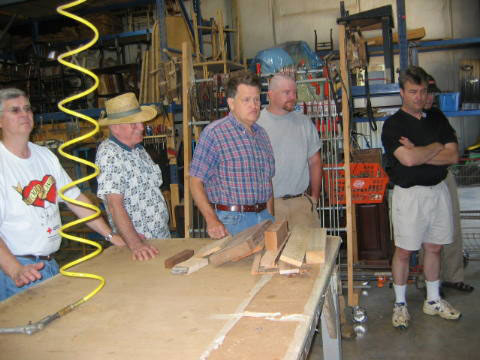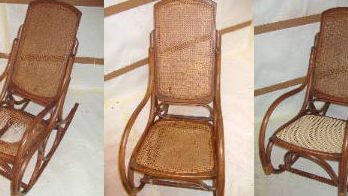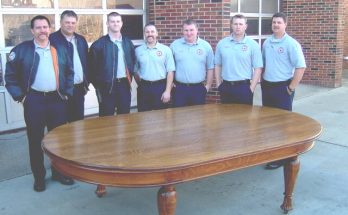Today’s woodworking class was held at McLean’s Refinishing and the subjects of discussion were wood glues and wood moisture content. Wood Moisture Meters were demonstrated and several different types of Glues for Woodworking were discussed.
Prior to the class, Fred conducted a tour of the McLean’s Refinishing shop area to give some of the new people an idea of how his antique refinishing and furniture repair shop was set up and show them some of the furniture repairs and refinishing projects currently underway. Fred has from 70-100 projects ongoing at all times.
According to Fred, the highest priority in is his shop is safety. He says that in this type of operation, safety is paramount. Personal safety, fire safety, and environmental safety are all taken very seriously at McLean’s Refinishing. For example, all of the finish stripping is done with alcohol instead of petroleum-based strippers, in an open area with fresh air venting. Furniture is “bathed” over a large tub that catches and recalculates the alcohol stripping agent. When the stripper is too dirty for continued use, it is recycled for brick firing ovens, and then the ash from the ovens is recycled into cement.
The next priority is educating customers about their antiques and the best way to restore them. Fred related a story of one customer who brought in a beautiful mahogany table who wanted him to refinish the top to get the “brush strokes” out of the finish. Fred had to explain to her that those “brush stokes” were actually the grain of the wood, not brush strokes in the finish.
Getting to the actual refinishing, Mclean prefers to use lacquer or shellac finishes for most wooden furniture. Lacquer finishes let the grain of the wood show through and produce a smooth, even finish. By adding one or two coats of shellac to a piece of figured wood, you can achieve a stunning effect called “chatoyance,” from the French meaning “like a cat’s eye.” If you’ve ever seen the semiprecious stone Tiger-Eye, you’ll notice that as you change your viewing angle, the light and dark bands of color change places; this is chatoyance. After the interesting tour and some group questions, it was on to the class.
Glues For Woodworking
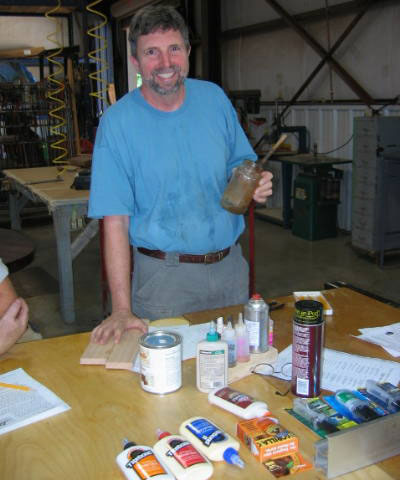
One of the best glues for furniture making and repair is animal glue, usually referred to as hide glue. Hide glue has been used in furniture making for hundreds of years and is still one of the best glues available, especially when working with antiques. Traditional animal glues are made from processed animal skin and bones and are very tough and durable. Hide glue is purchased in granular form and is mixed with water and heated to around 140 degrees for use. It is very strong, sets up rather quickly and does not require a lot of clamping. Many jobs can be done with no clamps. Just apply the glue to the pieces of wood, rub them together and let them air dry.
A great characteristic of hide glue is that it is reversible. If you misalign a joint or damage a piece, you simply apply moist heat and the joint comes apart. This characteristic is extremely valuable when working with antiques. Antique chairs and other furniture can be taken apart for repair or refinishing by applying moist heat to the joints and pulling the pieces apart.
For reassembly, this same glue is used for a secure ageless bond. Two other hide glue example was demonstrated in the class using a circa 1850 veneered table. The top of the veneered table had no damage, but there was a “hollow” area under the veneer where moisture had made the glue release over time. This piece was repaired by simply placing a damp cloth over the spot and using an iron to rejuvenate the glue. Fred also demonstrated hammer veneering using hide glue. Using hide glue, a special wooden mallet was used to press veneer around a curved leg of the table. The fast-drying hide glue kept the veneer attached to the table leg as it was pressed into place with the mallet. There were no clamps or vacuum bags needed to secure the veneer to the table base.
Fred also discussed the new Titebond brand glues now on the market, as well as a stainable glue, and epoxy glues. The newest of the Titebond family is Titebond III. Titebond III Ultimate Wood Glue is the first one-part, water cleanup wood glue ever offered that is waterproof. The waterproof formula passes the ANSI/HPVA Type I water-resistance specification and offers superior bond strength, longer open assembly time, and lower application temperature than previous formulas. Titebond III is non-toxic, solvent-free, and cleans up with water – safer to use than traditional waterproof wood glues. It provides a strong initial tack, sands easily without softening, and is FDA approved for indirect food contact (cutting boards). The ultimate in wood glues – ideal for both interior and exterior applications, but is not recommended for underwater applications.
Another great product from Titebond is Titebond Dark Wood Glue. It is a dyed version of Titebond Original Wood Glue that is colored to match dark stained wood furniture. It provides a strong initial tack and fast speed of set to reduce clamp time. It also develops a bond stronger than the wood itself, offers excellent standability, and is unaffected by finishes. Titebond Dark can help any woodworker achieve professional-looking results. It is ideal for wood, hardboard, particleboard, leather, cloth, and most other porous materials. Titebond Dark is easy to use, non-toxic, and cleans up with water.
Elmers has just released a stainable version of their popular wood glue. Fred has not completed testing on this new stainable glue, so come back to McLean’s Refinishing soon and find the results of our tests with this new product.
Epoxy glues are sometimes used in antique furniture refinishing woodworking, especially when working with materials other than wood. Fred has found that some of these epoxy glues can be colored using dyes to match the material you are using it for. An example used was the repair of an antique table with a marble top. Epoxy glue was tinted to match the color of the marble grain to hide the repaired crack. The dyed epoxy matched the grain of the marble almost perfectly.
Moisture Meter For Woodwork
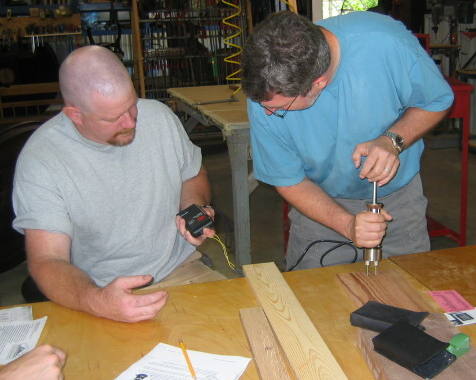
Working with wood, especially when making repairs to old furniture with new pieces of wood, requires understanding the moisture content of the wood. Wood expands and contracts as the moisture content rises and falls. Repairs to furniture require the same type of wood, and the new wood’s moisture content to be very close to the wood of the furniture being repaired. Using different types of wood or wood with different moisture contents can cause the piece to warp or separate after repair. For best results, wood repairs should be made when the wood moisture content is 10 to 14%.To check moister content, Fred demonstrated two types of Wood Moisture Meters. One had small pins that were pressed slightly into the wood for a reading, and the other had longer pins that could be driven into the wood to a depth of about an inch to get a more accurate moisture reading. During the demonstration, both types of meters produced very similar readings for several different types of wood. There are many types and brands of meters available, most retailing for $200-300, but don’t overlook E-bay or Used Tool Stores in your area.
Thanks for stopping by and if you live in the Athens, Georgia area, we would be happy to have you attend the next class. Just give a call or stop by McLean’s Refinishing.

